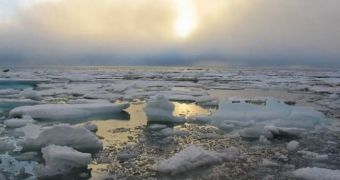As the global average temperature increases, the areas around the North Pole are beginning to melt, exposing the cold, darker water underneath to sunlight. This meltdown facilitates the opening of new trading routes, but this has further negative consequences on the environment.
While many analysts rejoiced when they learned that new passages through the Arctic Ocean may be unlocked soon, there is not to be happy about here. As the wold warms, and Arctic waters subside, a vicious circle is formed.
In fact, strictly speaking, there are two sorts of vicious circles that promote Arctic meltdown, and human activities have everything to do with both of them.
On one hand, anthropogenic (man-made) global warming is forcing ices to melt. This means that the water around the Arctic is getting darker. Given that darker colors absorb sunlight better, the waters are getting warmer by the day.
The ice that doesn't melt due to climate change then starts to melt due to the fact that it sits in hotter water. The more ice is melted, the more ice melts as a direct result.
The second self-sustaining mechanism is a bit more mundane. As ices are cleared from the region, more ships pass through, polluting the area and emitting greenhouse gases, which further contribute to the warming.
Investigators from the United States and Canada say that the newly-opened navigations channel could spell disaster for the Arctic Ocean, as they are capable of increasing existing warming rates by 17 to 18 percent.
Details of the new work appear in the latest issue of the esteemed journal Atmospheric Chemistry and Physics, in a paper entitled “Arctic Shipping Emissions Inventories and Future Scenarios.”
University of Delaware professor of marine science and policy James J. Corbett approached the research effort from a geospatial perspective, which allowed him and his team to determine the impacts of opening new shipping lanes on the Arctic.
“One of the most potent ‘short-lived climate forcers’ in diesel emissions is black carbon, or soot. Ships operating in or near the Arctic use advanced diesel engines that release black carbon into one of the most sensitive regions for climate change,” explains Corbett.
The expert also holds an appointment with the College of Earth, Ocean, and Environment at the University of Delaware, Science Blog reports.
“To understand the value of addressing short-lived climate forcers from shipping, you need to know the impacts of these emissions, the feasibility and availability of technologies that could be put in place to reduce these impacts, and then engage the policy-making community to debate the evidence and agree on a plan,” Corbett argues.
“Our hope is that this study will enable better communication of emerging science with policy makers and aid the eight Arctic Council nations with climate policy,” he concludes.

 14 DAY TRIAL //
14 DAY TRIAL //